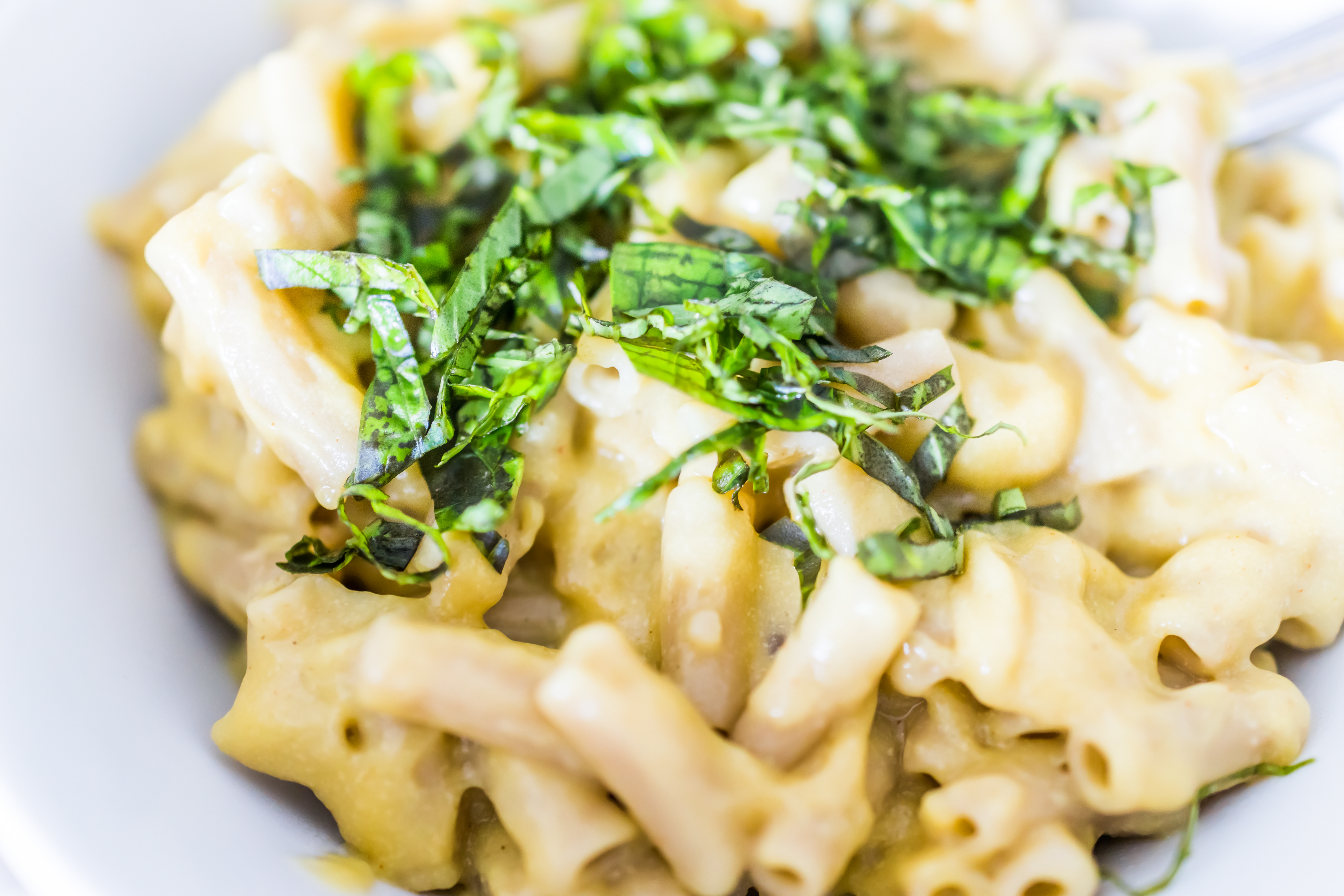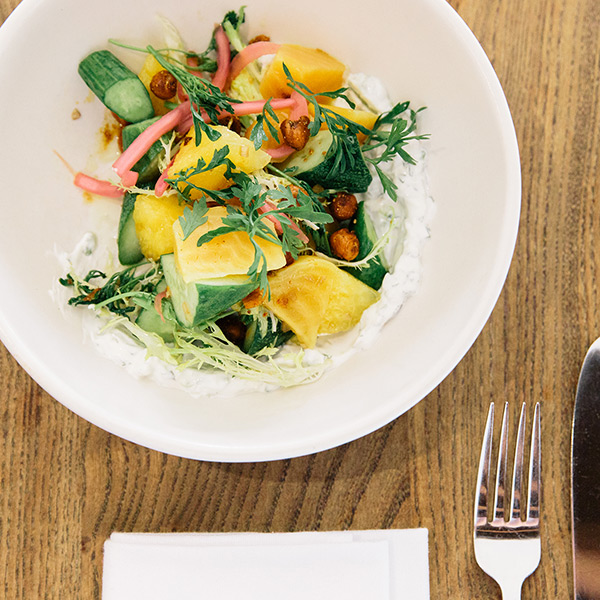The first thing people say to me when contemplating whether or not to give up dairy is: “But I could never live without cheese.”
I sympathize with that concern, but having followed a plant-based lifestyle for years now, I feel it’s really just a matter of knowing your options.
As a chef, I’ve explored the function that ingredients play in our food – is it included for texture? For moisture? For saltiness or crispness? Or even, speaking about nutrition, for fat or protein?
All of these things are true about dairy. In smoothies, yogurt is added for protein. In sauces, milk is added for creaminess. In sandwiches, sliced cheese is added for saltiness and protein whereas spreadable cheeses are added for moisture, texture, and the satiating effect of fat. In baking, particularly in casseroles, cheese is sprinkled on top to provide a crispy layer over all of the staple ingredients in the dish. And in pasta, Parmigiano and Pecorino are grated overtop to give the first several bites (the most important of all bites) a *pop* of flavor.
You can achieve the same desired effect with a multitude of delicious, plant-based ingredients, a little creativity and a trip to your natural food store. Here are our favorite dairy substitutes.
11 Dairy Substitutes for Vegans and Non-Vegans Alike
1. Sundried Tomatoes
Salty, sweet, and slightly sour, these bright red beauties provide a unique blend of cheese-like characteristics that mimic the sharpness of Pecorino. Try a sandwich or wrap with lettuce, thinly sliced onion, avocado, and sundried tomatoes with a smear of pesto for a perfectly satiating sandwich experience sans cheese. You can also add chopped sundried tomatoes to salads and pasta for a similar effect.
2. Avocado
With all of the natural plant-based richness you can imagine, avocado can completely fill that need for something creamy in your dish. Mashed with salt and spread on sandwiches, it can replace goat cheese. Diced, tossed with lemon juice, and tossed into pasta salad, it can replace feta. My current obsession is avocado mashed with Dijon mustard and spread on toast with a sprinkle of capers and baby arugula: forget toast with butter, this is the ultimate breakfast food.
3. Nutritional Yeast
Long loved for its aged cheese flavor (and long mocked for its terrible name), nutritional yeast is an easy stand-in for cheddar when sprinkled over breakfast potatoes and broccoli, among other things. When mixed with sea salt and ground nuts, it’s reminiscent of the aged and nutty flavor of Parmigiano and is delicious over pasta. Nutritional yeast can also be blended into nut-based sauces to create a dairy-free alfredo sauce.
4. Miso
Also tart and aged, a little miso stirred into pesto and nut-based sauces adds a complexity that’s usually occupied by cheese. I prefer lighter miso pastes such as white and yellow miso or, my current favorite, South River Miso Company’s Organic Golden Millet Miso. Interesting side note regarding millet – when millet is toasted, either prior to cooking the grain or when millet flour is blended with bread flours and subsequently toasted in the oven, it emits a sweet fragrance, not unlike buttered popcorn.
5. Shoyu and Tamari
Shoyu, traditionally fermented Japanese soy sauce, and Tamari, traditionally fermented Japanase soy sauce made without wheat, provide the umami flavor so often filled by animal proteins. The flavor of umami, characterized as a satiating “pleasant savory taste”, results from the presence of L-glutamate or glutamic acid, an amino acid that occurs naturally in protein-rich foods like meat and cheese. It can also be created with MSG (monosodium glutamate), a food additive that causes adverse reactions in many people. While L-glutamate is found in animal proteins, it’s also naturally occurring in soy products. Shoyu and Tamari are my secret weapons for creating truly delicious roasted and sautéed mushrooms. When combined with olive oil, it almost tastes like you’re cooking in butter.
6. Truffle Salt
Truffle salt imparts a rich earthiness to dishes, an element of dairy that is not achieved with many other dairy substitutes. For me, the flavor of the earth conjures up the flavor of grass that can just barely be detected in cheese. Try a great quality truffle salt like Casina Rossa’s Truffle and Salt as a finisher on pasta, in blended nut-based sauces, or in combo with nutritional yeast on popcorn for the most heavenly popcorn you’ve ever tasted.
7. Coconut
Rich, creamy, soft and blendable, coconut in so many forms can be substituted for dairy. The meat of young Thai coconut, when added to smoothies, gives body and texture much the way that yogurt does. Thick coconut milk from a can (try Native Forest’s which is organic and packaged in BPA-free cans) when chilled can be whipped like whipped cream to top cakes and serve as a dip for strawberries.
8. Cashew Butter
My go-to nut for creamy nut-based sauces, cashews are mild and sweet making them a perfect substitute for whole milk. Soak raw cashews for two hours, and then add them to smoothies or as a base for your dairy-free alfredo. For a fast and easy fix, raw cashew butter works like a charm.
9. Breadcrumbs
What casserole would be complete without a crispy layer on top of all of the goodness baked inside? My grandmother, who made the world’s greatest baked macaroni and cheese, finished hers with a hefty dose of grated cheddar that baked into a crispy golden-brown layer that I happily scooped off before anyone else had a chance to indulge. Nowadays, I conjure her spirit by finishing a vegan baked macaroni and cheese with a generous layer of seasoned bread crumbs – which also turns golden-brown in the oven … and which I’m still hard-pressed to share.
10. Chopped Olives and Capers
Salty, briny, and full of umami, chopped olives and capers are brilliant in place of grated cheeses on pasta and salad.
11. Fresh Chopped Herbs
Chopped herbs sprinkled over a dish just before serving provide a burst of flavor. Finish your dishes with a handful of chopped parsley, tarragon, cilantro, basil, or chives to add delicious dimension. Or creatively mix your own herb salts and peppers to finish dishes, such as Rosemary Black Pepper or Lavender Sea Salt. Lastly, get cozy with lesser-known varieties of herbs like Lemon Thyme, Lemon Verbena, Rose Geranium, Thai Basil, Chervil, and Epazote. They will add an unexpected element to your food that will leave guests wondering what on earth makes your food so exotic and enchanting.
Originally posted 2014-02-28 20:22:00.








I work with a lot of diary and wheat people. Your Alfredo sauce looks amazing.. Whats in it?
Thanks , Linda